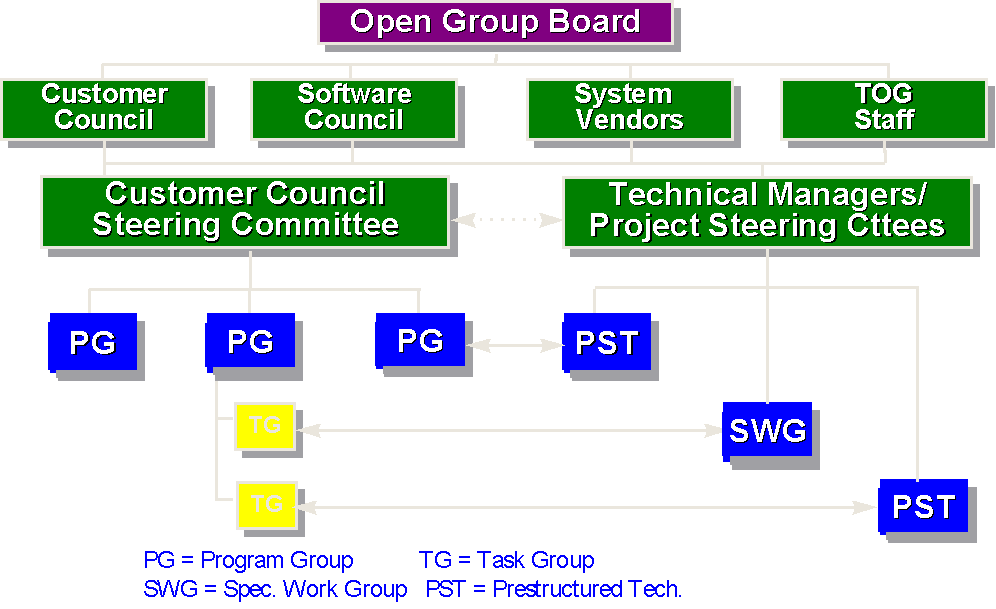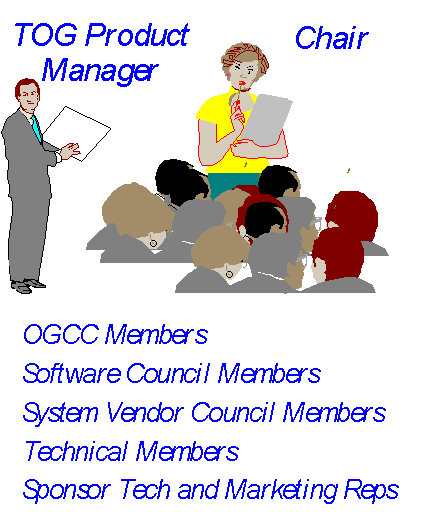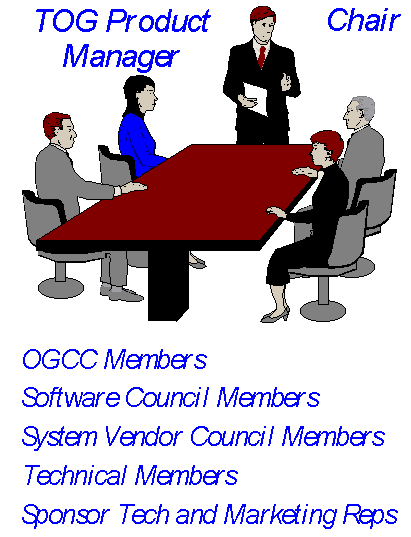

The Open Systems Process is intended to act as an impetus to the
Open Systems movement by bringing together customers who need
solutions to their open systems requirements and suppliers who
desire to work with a representative customer market for the open
systems technologies they intend to develop into products. Customer
Council members, as representative of buyers in the market, have
the primary charter for the identification of requirements and
selection of Program Areas. Sponsors, Software Council members
and System Vendor Council members have the primary responsibilities
for identification and development of the components needed to
broaden the open systems market including specification, technology
implementations through collaborative development, and branding
programs. Working together these constituencies identify the market
priorities and intersects between requirements and technology,
and work together to achieve accelerated delivery of open solutions.
The Open Systems Process is open to all stakeholders. A
collaborative process between customers and suppliers will accelerate
the delivery to market of products which meet widely accepted
customer requirements and conform to industry standards. The process
should encourage rather than constrain the independent actions
of suppliers coming together to develop technology or specifications
collaboratively.
The process operates within the organizational framework
shown below.

|
The goal of a Program Group
is to agree on priorities, identify the tasks needed to implement
solutions to priority items and organize into subgroups to drive
timely task execution. The Program Group also provides a feedback
loop within a focus area by having the subgroups report progress
to the broader Program Group. These actions and activities are
documented by developing a Program Plan
which communicates agreed requirements, goals and objectives for
that Program Group, the business and technical drivers, its direction
and its position along the road to realizing those goals. It recognizes
where The Open Group can add value, and identifies the priorities
that should be refined further by The Open Group. The Program
Plan for each major area of focus will be the responsibility of
the Program Group for that area.
This process will stimulate future collaborative development of
implementations or tests. Collaborative development proposals
or sponsorship of test suites can also be submitted by suppliers
for areas not covered by the Program Plan.
The Program Group normally works through subgroups called Task Groups
to conduct the more detailed work
required to develop, as appropriate, project plan, requirements,
specifications, technologies, branding programs, and interaction
with related technical activities such as PSTs, SWGs, etc. to
produce the desired deliverables.
For more information see The Open Systems Process in detail
 | Program Groups are created or dissolved
as needed to provide focus on key open systems technology areas. At the time of
writing these are:
Architecture,
Information Superhighway,
Interoperability,
DCE,
Distributed Systems Management,
Security
and the Operating Platform (XPG4 Base & UNIX).
Any TOG member or sponsor may appoint representatives to a Program Group. Each Program Group will elect its own Chair and a member of TOG staff will be appointed as Program area Product Manager. Return to Process Overview |
 | Once all constituencies agree on the priorities that need to be developed fully, a Task Group may be formed to progress customer requirements, identified priority items and other specific tasks, for example, act as or provide liaison to Specification Working Groups, PST Authoring Groups or other TOG centered technology development activities as deemed necessary.
Generally, there will be two parts to each Task Group: one that deals with business issues/requirements and one that deals with technical issues. These will often work in parallel, coming together for up-dates and joint sessions to ensure that the overall project is synchronized. This is particularly relevant where technology is being developed, e.g., DCE, CDE, or Security. The Board will need to approve any PSTs ( or RFTs, ATOs) that result, the Branding Program, and the business plans for the launch of new products. Any TOG member or sponsor may appoint a representative(s) to a Task Group. Each Task Group shall elect one of its members to serve as Task Group Chair. Task Group recommendations, approvals and actions will be determined by majority consensus with each Task Group member organization having one vote. Return to Process Overview |
Program Groups and associated Task Groups may elect to work in any manner they consider effective for their purpose outside of the TOG Quarterly Member Conferences. Some may prefer regular Quarterly Conference venues, others may prefer to meet asynchronously, while others may prefer to conduct their work via e-mail, WWW or other electronic media. In addition, The Open Group Quarterly Member Conferences provide venues for Program and Task Group Meetings. Presently, Program Groups meet at least at two of the Quarterly Conferences and the Program Group Chair, or designated substitute, provides a report back to the membership at large at those meetings where the full Program Group does not meet. Participation in broader meetings allows different program groups to exchange and compare ideas and results.
Pre-Structured Technology initiatives (PSTs) and
Specification Work Groups (SWGs) are directly funded by their
sponsoring companies. This funding recovers TOG's costs of facilitating
the process and of specific deliverables that have to be delivered
by TOG either in-house or out-sourced.
Council Members are entitled to elect representatives (usually
from the associated Program or Task Group) to participate in SWGs
and track PST execution. Those representatives should report back
to the Councils via the Task/Program Groups on the activities
of the working group they have been elected to attend (observing
the non-disclosure rules of the group, without which the participants
would not submit materials for consideration).
See Collaborative Technology procedures and Technical Procedures for more information.
Overall, Program Groups have a flexible structure,
and are given a high degree of self-governance. In recognition
of the need to provide a level of continuity and support to the
Program Groups and process as a whole, administration and infrastructure
support is the responsibility of The Open Group management and
staff. Oversight and management of the process is the responsibility
of the elected Council Executive Committees and Board of Directors.